Our Aim
To provide you with an overview on New And existing technologies, hopefully helping you understand the changes in the technology. Together with the overviews we hope to bring topical issues to light from a series of independent reviewers saving you the time And hassle of fact finding over the web.
We will over time provide you with quality content which you can browse and subscribe to at your leisure.
TekSpek 's

NVIDIA GeForce RTX 2080
Date issued:
Graphics Reimagined
It is no secret that NVIDIA is overhauling its high-end graphics solutions with the launch of the GeForce RTX 2080 Ti and GeForce RTX 2080. Priced at £1,099 and £749, respectively, in Founders Edition guise, the hard-hitting duo are powered by a revolutionary Turing architecture that promises to change the way we think about PC gaming performance in the years ahead.
Our previous TekSpek delved into the finer workings of the architecture, and for today's follow-up we're going to take a closer look at the cards themselves as well as some eagerly-anticipated benchmarks.
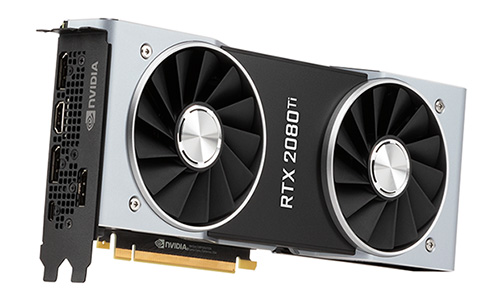
The first thing you'll notice is that NVIDIA has fully revamped its Founders Edition design. Gone is the single-fan cooler of prior generations and in comes a dual-fan successor that looks incredible and is built like a tank. Retaining a dual-slot form factor and measuring 10.5in long, the new FE is a stunning feat of engineering and, though the branding on the front and back may differ, would-be buyers will appreciate the fact that both the RTX 2080 Ti and RTX 2080 use the exact same cooling design.
Said design includes a full-length vapour chamber, 13-blade axial fans driven by a three-phase motor, and an illuminated GeForce RTX logo across the top. Start to look closer and you do see small differences that set the top-of-the-range Ti card apart. These include an eight-plus-eight power connector, as opposed to eight-plus-six on the regular RTX 2080, and an internal power configuration that is more befitting a £1,000+ product.
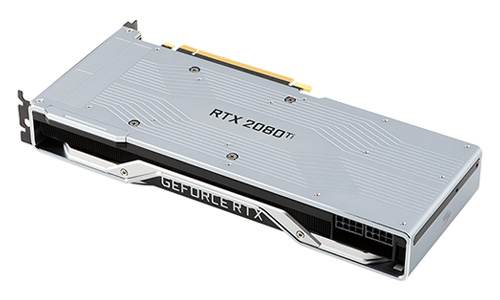
RTX 2080 Ti is outfitted with a 13-phase iMON DrMOS supply with dynamic a power management system that NVIDIA reckons is capable of "sub-millisecond current monitoring and control," allowing for more headroom and greater overclocking potential. The GDDR6 memory gets a three-phase supply of its own, and in contrast, the regular RTX 2080 makes do with an eight-phase design for the GPU and two-phase for memory.
As expected, display outputs cover all bases with the inclusion of HDMI 2.0b, a trio of DisplayPort 1.4, and a USB Type-C jack supporting VirtualLink; an open-industry standard geared toward next-generation VR headsets.

You only need to take one look at the RTX 2080 Ti's gargantuan 754mm² die to know that NVIDIA isn't messing around with its latest and greatest. Featuring a whopping 18.6-billion transistors, the 12nm TU102 boasts 4,352 shaders, additional RT and Tensor Core hardware, improved caches and an 11GB GDDR6 frame buffer hooked-up via a 352-bit bus. The numbers alone suggest that NVIDIA's new champ will be significantly faster than GTX 1080 Ti, and yet it's worth noting that RTX 2080 Ti does not utilise a full implementation of TU102; the full-fat 4,608-shader variant is currently reserved for workstation-specific Quadro cards, though may some day feature as an RTX-generation Titan.
Dropping down a notch, RTX 2080's TU104 still employs a die that is larger than the outgoing GTX 1080 Ti, providing 2,944 shaders, forward-looking Tensor and RT Cores, and 8GB of GDDR6 memory attached via a slightly narrower 256-bit bus. Going by the specification alone, RTX 2080 appears to have been built specifically to replace GTX 1080 Ti in the performance stakes.
| NVIDIA's Founders Editions: RTX vs. GTX | ||||
|---|---|---|---|---|
| GeForce RTX 2080 Ti | GeForce GTX 1080 Ti | GeForce RTX 2080 | GeForce GTX 1080 | |
| Launch date | September 2018 | March 2017 | September 2018 | May 2016 |
| Codename | TU102 | GP102 | TU104 | GP104 |
| Architecture | Turing | Pascal | Turing | Pascal |
| Process (nm) | 12 | 16 | 12 | 16 |
| Transistors (bn) | 18.6 | 12 | 13.6 | 7.2 |
| Die Size (mm²) | 754 | 471 | 545 | 314 |
| Core Clock (MHz) | 1,350 | 1,480 | 1,515 | 1,607 |
| Boost Clock (MHz) | 1,635 | 1,582 | 1,800 | 1,733 |
| Shaders | 4,352 | 3,584 | 2,944 | 2,560 |
| GFLOPS | 14,231 | 11,340 | 10,598 | 8,873 |
| Tensor Cores | 544 | - | 368 | - |
| RT Cores | 68 | - | 46 | - |
| Memory Size | 11GB | 11GB | 8GB | 8GB |
| Memory Bus | 352-bit | 352-bit | 256-bit | 256-bit |
| Memory Type | GDDR6 | GDDR5X | GDDR6 | GDDR5X |
| Memory Clock | 14Gbps | 11Gbps | 14Gbps | 10Gbps |
| Memory Bandwidth | 616 | 484 |
|
320 |
| ROPs | 88 | 88 | 64 | 64 |
| Texture Units | 272 | 224 | 184 | 160 |
| L2 cache (KB) | 5,632 | 2,816 | 4,096 | 2,048 |
| Power Connector | 8-pin + 8-pin | 8-pin + 6-pin | 8-pin + 6-pin | 8-pin |
| TDP (watts) | 260 | 250 | 225 | 180 |
| Launch MSRP | $1,199 | $699 | $799 | $699 |
Juggling the numbers doesn't always reveal the full picture. These may well be the finest Founders Edition cards that NVIDIA has created, yet the forward-looking design of the Turing architecture is such that RTX cards are attempting to deliver incredible gaming today as well as future performance benefits that will be unlocked as developers get to grips with the new hardware.
Leading review sites have put the NVIDIA RTX cards through their paces, and the benchmarks are eye-opening to say the least.
Performance Supremacy
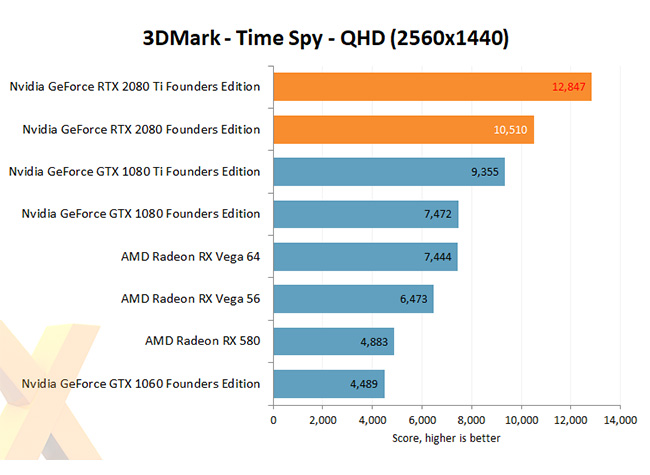
Want the very best GPU that money can buy? Look no further than GeForce RTX 2080 Ti. Going by the synthetic 3DMark Time Spy results, NVIDIA's latest is almost 40 per cent quicker than the previous-generation GTX 1080 Ti.
Continuing the theme, RTX 2080 proves to be just over 40 per cent superior to the GTX 1080 that launched back in May 2016. It has taken a while for NVIDIA to update its stable, but if these numbers are anything to go by, RTX has been worth the wait.

Yet while the performance bar has been raised, it's important to remember that such high-end cards are aimed at a specific audience. If you're gaming at FHD or QHD resolutions, RTX 2080 Ti or indeed RTX 2080 could be deemed overkill. These powerhouses prove their worth when tasked with high-quality gaming at a lush 4K resolution.
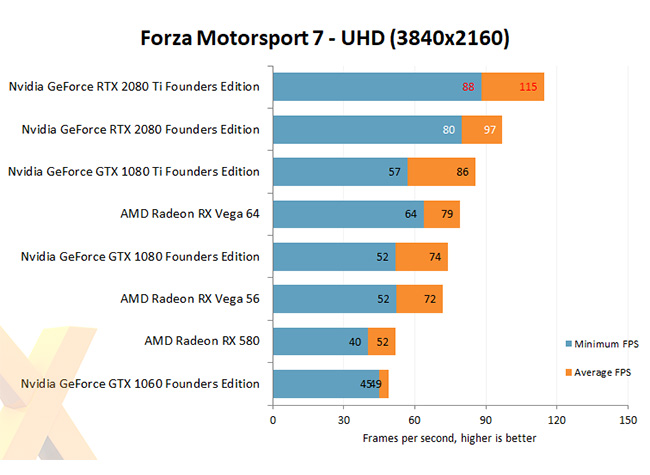
Considering an upgrade from a GeForce GTX card? RTX represents a significant step-up, and though the price tag for the flagship 2080 Ti is lofty, that's hardly going to deter the die-hard enthusiast who'll settle for nothing less than that best.
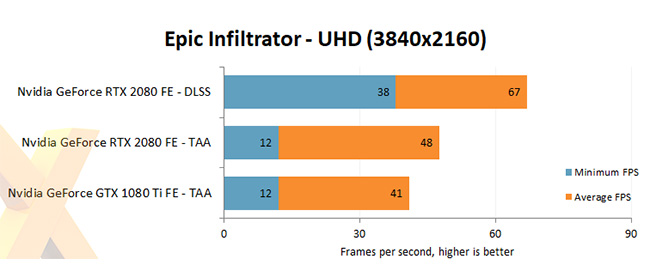
But there's more to RTX graphics cards than just brute speed. Turing's advanced architecture places a particular emphasis on real-time ray tracing, artificial intelligence, and programmable shading. One of the most promising benefits is Deep Learning Sub-Sampling (DLSS), an RTX-exclusive technology that "uses the power of deep learning and AI to train the GPU to render crisp images, while running up to 2x faster than previous generation GPUs using conventional anti-aliasing techniques."
25 games are said to be supporting the feature shortly after RTX availability at retail, and early benchmarks suggest that the performance advantage can be considerable. In the above graph, using the Epic Infiltrator demo, performance jumps from 48fps to 67fps when switching from traditional TAA to DLSS. Proof, it seems, that while RTX is already quick, it will only get faster with time.
Summary
Make no mistake, the GeForce RTX 2080 Ti and RTX 2080 are the most exciting graphics cards ever released by NVIDIA. Hitting all the right notes, the Turing GPUs are exquisitely designed to deliver best-in-class performance today, with the promise of revolutionary technologies to come. Want to experience 4K gaming while keeping the door open for ray-tracing, artificial intelligence and performance-enhancing DLSS? is the place to be.

A full range of NVIDIA GeForce RTX graphics cards are, of course, available to purchase here at Scan Computers.